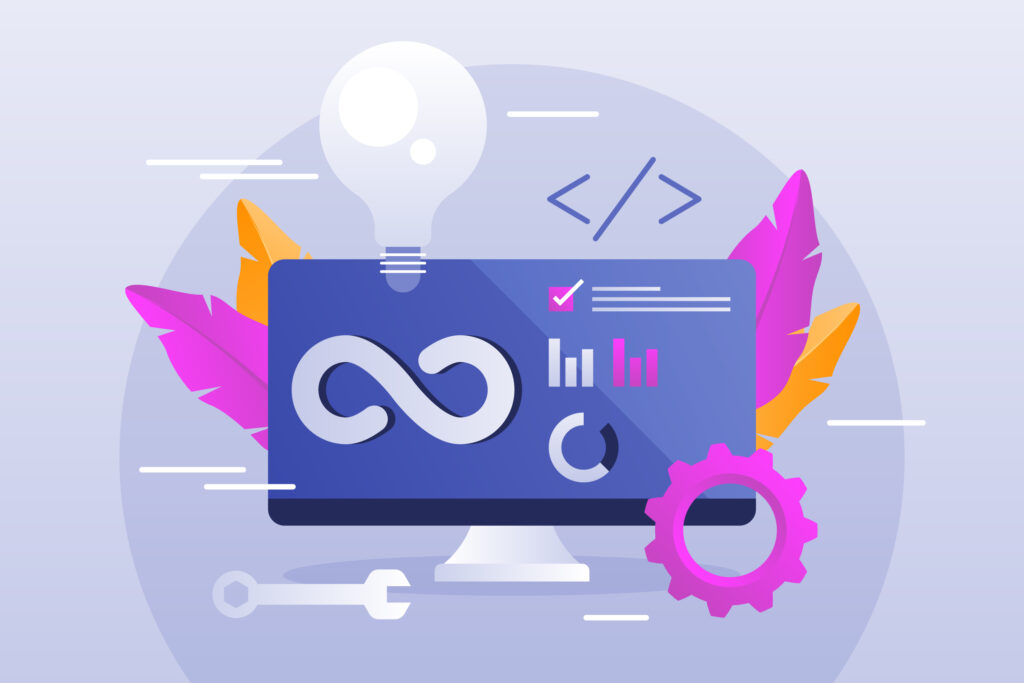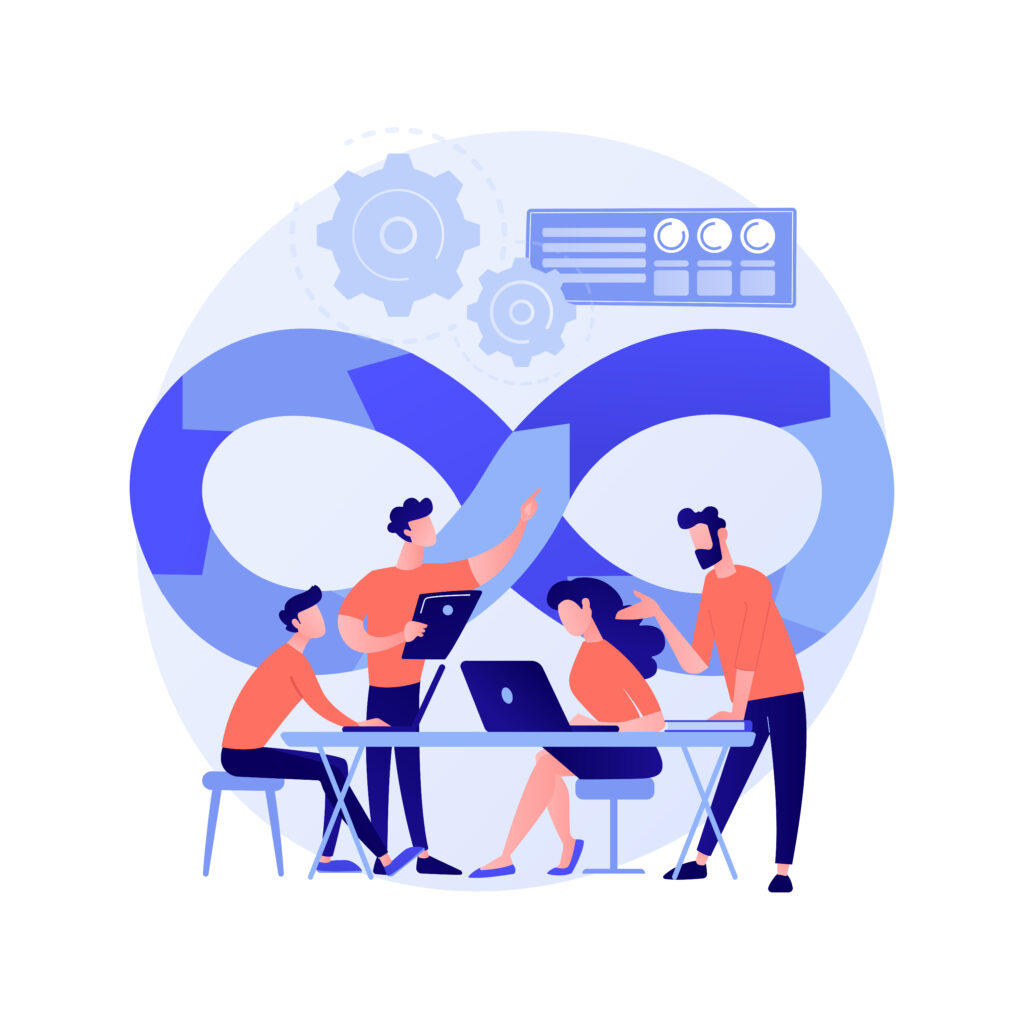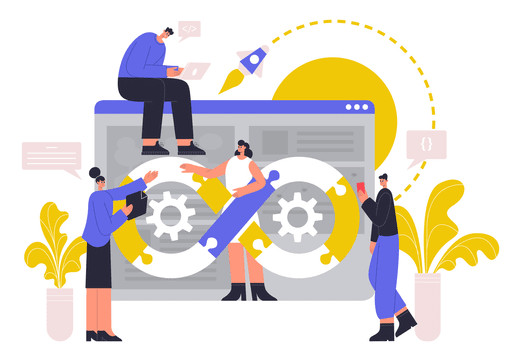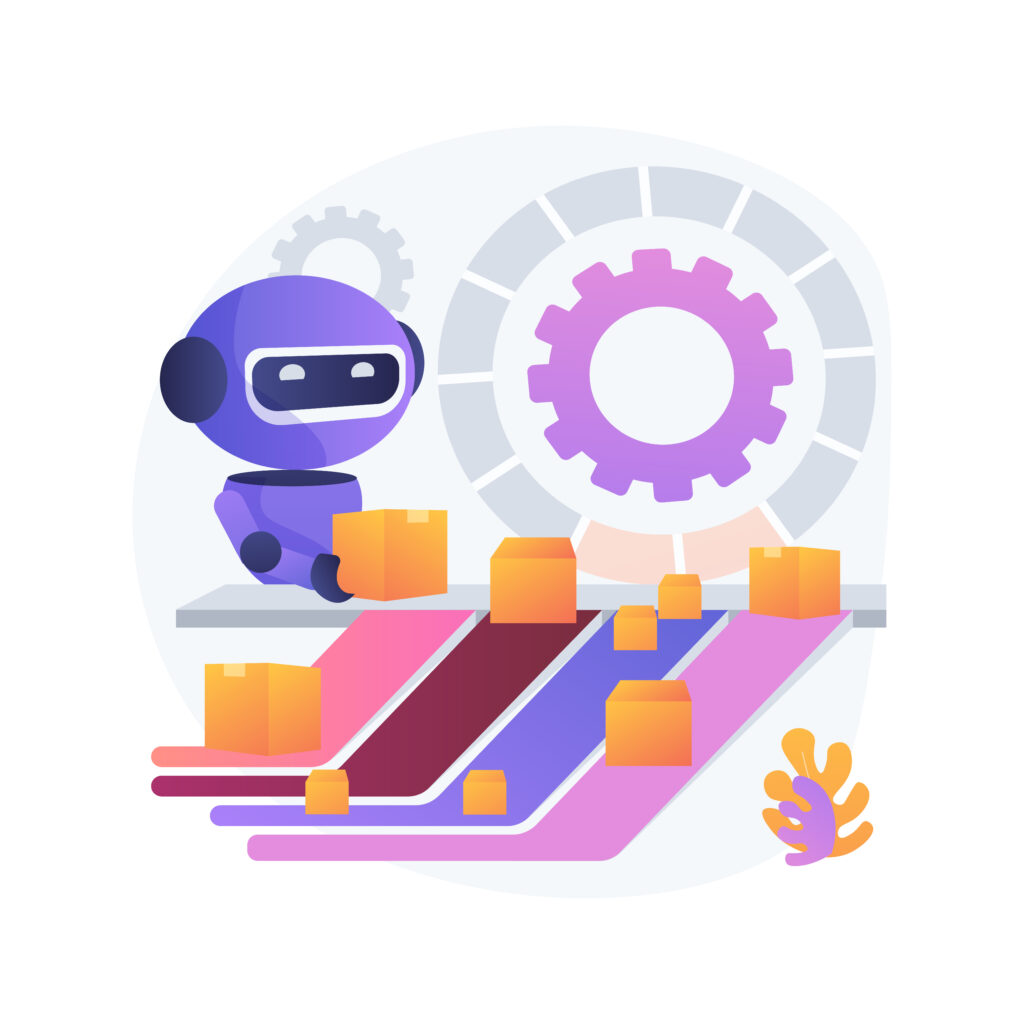ML Ops vs DevOps: What Are They?
It is always important tot have a detailed comparative studies on ML Ops vs DevOps. DevOps refers to the collaboration between software developers and IT operations teams. Recently, a new concept known as MLOps, which merges DevOps principles with machine learning (ML), has been gaining significant traction.

Both DevOps and MLOps are strategies that foster collaboration among developers, operations, and data science teams. However, the primary distinction lies in their focus areas: DevOps centers on application development, whereas MLOps concentrates on machine learning.
DevOps integrates programming, testing, and deployment processes for web applications and software. Similarly, MLOps seeks to streamline the lifecycle of machine learning projects by integrating the DevOps model into ML workflows. This approach creates a seamless, efficient process with fewer barriers. Let’s explore the differences between DevOps and MLOps step by step.
What is DevOps?
In a software organization, two main teams typically exist: the development team, which creates systems, and the operations team, which tests and deploys them. Occasionally, the operations team provides bug-related feedback, which can delay the development cycle.
DevOps aims to eliminate these barriers by fostering collaboration between development and operations teams. It is a widely adopted IT approach encompassing software development, operations, and system management. DevOps isn’t limited to a single tool or method it’s an approach that enhances operational agility by encouraging teamwork among developers and leveraging both manual and automated systems.
How Does DevOps Work?
DevOps bridges the gap between Development and Operations teams, breaking down the silos that traditionally separated them. Previously, these teams worked in isolation, relying heavily on time-consuming meetings and emails for coordination.
With DevOps, the focus shifts from individual departmental objectives to broader organizational goals. This approach encourages collaboration and proactive problem-solving. By utilizing automation tools and accelerating processes, teams can work more closely to identify and address issues quickly.

DevOps emphasizes security while automating and monitoring the entire software delivery pipeline, from development through to production.
DevOps fulfills several important objectives:
- Accelerating the launch of new features
- Enhancing customer and developer satisfaction through streamlined workflows
- Establishing feedback loops to improve communication
The core principles of DevOps are:
- Automation
- Self-service
- Collaboration
- Iteration
- Continuous improvement
- Continuous testing
DevOps Lifecycle
The DevOps lifecycle consists of four primary stages, often visualized as an infinity loop. These stages form a continuous feedback loop, enabling organizations to deliver high-quality, thoroughly tested solutions to customers at a rapid pace.
- Design and Plan
The lifecycle begins with planning, where stakeholders from business, development, and IT teams collaborate. Together, they identify the features to include in the development cycle and evaluate their potential business impact.
- Continuous Integration
Continuous integration encompasses three key steps: coding, building, and testing. This approach focuses on enhancing product quality through automation. Code changes are frequently merged into a central repository, where automated tools retrieve the codebase, test its quality, and build a functional binary solution. Both manual and automated testing are used to generate detailed reports, ensuring the organization benefits from comprehensive insights.
- Continuous Deployment
In this stage, the Release and Deploy phases are combined. Consequently, quality-tested builds are automatically released and deployed to pre-production or production environments. Additionally, the DevOps team can adjust the frequency of releases and deployments based on specific project needs.
- Continuous Monitoring
The final stage, continuous monitoring, involves two key activities: Operate and Monitor. Teams oversee the software’s operations, gather critical data on security and performance, and collaborate to resolve issues quickly and efficiently.
DevOps Benefits
It offers organizations greater flexibility, fosters collaboration and communication, and accelerates product or service delivery timelines.
- Increased Agility
A cornerstone of DevOps is automating the software development and delivery process. By automating repetitive tasks such as code testing, software deployment, and infrastructure setup, DevOps allows organizations to adapt to changes swiftly and efficiently.
- Faster Time to Market
DevOps enables quicker deployment of new code changes, including bug fixes and new features, by automating tasks like testing and deployment. With a focus on secure solutions, DevOps enhances the speed and flexibility of development and operations teams. This efficiency helps businesses remain competitive by offering timely and readily available solutions.
- Enhanced Security
Security is integral to DevOps, often referred to as DevSecOps. This approach embeds security measures throughout the development process rather than addressing them only at the end. By identifying and resolving security issues early, DevSecOps accelerates delivery while reducing the cost of addressing vulnerabilities, resulting in more secure and efficient solutions.
- Improved Communication and Collaboration
DevOps bridges the gap between development and operations teams, fostering better communication and collaboration. When these teams understand each other’s goals and priorities, they can address challenges more effectively and resolve issues faster. - Better Feedback Loop
A robust feedback loop collects insights from various stages of the organization and shares them with relevant teams. DevOps streamlines this process with automation and “right-to-left” feedback, where information from later stages flows back to earlier ones. For instance, errors detected during the build phase are immediately communicated to the testing team for resolution. This continuous feedback mechanism accelerates processes and improves product quality.
DevOps Model Challenges

While the DevOps model enhances efficiency in development and deployment, it also presents certain challenges.
- Culture Shift
DevOps requires a significant cultural transformation. Development and operations teams must collaborate, embrace shared responsibilities, and work together to solve problems. If this cultural shift isn’t addressed early, it can impact the efficiency of both the development unit and the organization. Establishing a shared vision through open communication is a key strategy to overcome this challenge.
- Adoption of Tools
Implementing DevOps often involves replacing outdated systems with modern tools. While this transition can be challenging, training team members to use these tools is crucial. However, it’s not about adopting the latest tools indiscriminately. Instead, organizations should focus on selecting tools that best meet their specific business needs.
- Establishing Metrics and Processes
Transitioning to DevOps necessitates changes in workflows, such as setting up CI/CD pipelines or implementing automated tests. To ensure success, organizations must identify and track relevant metrics that align with their business goals.
Since managing all these changes simultaneously can be overwhelming, starting small with a pilot program and a basic testing framework can help streamline the process.
- Change Management
DevOps emphasizes continuous improvement and adaptability. Therefore, organizations must recognize that processes and tools will inevitably evolve as they progress in their DevOps journey or as products grow. To handle this effectively, organizations should, in turn, foster a culture of accountability, continuous learning, and adaptability. By doing so, they can ensure they meet changing demands seamlessly.
What is MLOps?
MLOps refers to a set of strategies specifically designed to automate the machine learning process by integrating model creation, development, and operational workflows. Moreover, it leverages DevOps principles within the realm of machine learning to effectively address challenges that are commonly encountered in ML projects.
Essentially, MLOps combines machine learning with DevOps methodologies to streamline the deployment of ML models. Furthermore, it ensures faster delivery of updates, much like DevOps achieves for software features.
Why MLOps?
Machine learning differs from traditional software development because it centers around data rather than static application behavior. ML systems are dynamic, requiring continuous monitoring, updating, and redeployment to maintain optimal performance as data evolves.
The MLOps pipeline ensures reliable insights are generated efficiently and in a controlled environment, refocusing efforts on operationalizing ML. Key benefits include:
- Enhanced Collaboration: MLOps unites expertise across teams to make ML workflows more effective.
- Streamlined Practices: By adhering to MLOps best practices, organizations can smoothly transition from ideas to production-ready models.
- Improved Efficiency: Expertise is allocated appropriately to minimize delays.
- Optimized Processes: The MLOps pipeline accelerates model training, tracks experiments, and enables robust API creation for deployment.
How Does MLOps Work?
The MLOps lifecycle comprises several essential steps:
- Extracting Data: Gathering raw data for analysis.
- Analyzing Data: Understanding patterns, trends, and insights.
- Preparing Data: Cleaning and organizing data for training.
- Training the Model: Building the ML model using prepared datasets.
- Evaluating the Model: Testing its accuracy and performance.
- Validating the Model: Ensuring the model meets predefined standards.
- Serving & Monitoring: Deploying the model for use and continuously monitoring its performance to ensure reliability and relevance.
Ways to Adopt MLOps
MLOps can be implemented in three progressive ways, depending on the complexity of the organization’s needs and its maturity in machine learning operations. Moreover, these approaches allow organizations to scale their machine learning capabilities effectively while addressing unique challenges at each stage.
1. Manual Process
This method is common for businesses just beginning to explore MLOps. It involves performing each step of the ML process manually, including:
- Data preparation
- Model training
- Testing
Tools like Jupyter Notebooks are frequently used for quick experimentation and iteration.
Pros:
- Simple and suitable for projects that don’t require frequent model updates or retraining.
Cons:
- Increased risk of model failure in production due to the lack of automation.
- Time-intensive and not scalable for more complex workflows.
2. ML Pipeline Automation
This approach is ideal for deploying models with updated data rather than experimenting with new ML ideas. It automates key steps like:
- Data handling
- Model validation
- Retraining
Features:
- Faster experimentation and continuous deployment of predictions.
- Components of the pipeline (e.g., data analysis code) are made reusable and shareable.
- Enables systems to adapt quickly to changes, such as shifts in customer behavior or market prices.
Requirements:
- Modularized code stored in repositories for better reusability.
- CI/CD infrastructure to automate tasks like model building, testing, and deployment when rapid experimentation is required.
3. CI/CD Pipeline Automation
This level of adoption is suited for tech-driven enterprises with frequent retraining needs, often in real-time or on an hourly basis.
Capabilities:
- Automates the creation, testing, and deployment of data pipelines, ML models, and training pipelines.
- Supports large-scale deployments, such as deploying models across thousands of servers simultaneously.
- Data scientists can efficiently experiment with new ideas, including feature engineering, hyperparameter tuning, and model design.
Phases of CI/CD in MLOps Pipelines:
- Data collection and preparation.
- Model training and evaluation.
- Testing new ML algorithms and models.
- Version control for pipeline stages in a source repository.
- Deployment across scalable infrastructures.
- Continuous monitoring and improvement.
Choosing the Right Approach
- Manual Process: Best for small-scale projects or businesses just starting with ML.
- ML Pipeline Automation: Ideal for enterprises needing scalable and adaptable systems.
- CI/CD Pipeline Automation: Suited for advanced organizations requiring frequent updates and rapid deployments at scale.
By selecting the right adoption level, organizations can optimize their ML workflows, improve efficiency, and stay competitive.
Benefits of MLOps
MLOps effectively bridges the gap between data teams, analysis operations professionals, and IT engineers by fostering collaboration and streamlining machine learning workflows. Moreover, its advantages range from improved model management to simplified deployments, thereby ensuring reliable and scalable machine learning operations.

1. Creation of Reproducible Workflows and Models
MLOps ensures consistency and traceability across the entire machine learning lifecycle by:
- Reproducible Learning: Making model iterations consistent and resilient for enterprise applications.
- Resource Tracking: Leveraging dataset and model registries to efficiently manage resources.
- Execution Monitoring: Providing robust traceability by logging code, data, and metrics.
- Consistent Delivery: Designing, deploying, and managing workflows through automated pipelines for reliable and repeatable results.
2. Easy Deployment of High-Precision Models in Any Location
MLOps streamlines the process of bringing machine learning models into production by:
- Rapid Deployment: Deploying models quickly and confidently.
- Scalability: Using automatic scaling with managed CPU/GPU clusters and distributed learning capabilities in the cloud.
- Model Packaging: Ensuring high-quality models through profiling and validation processes.
- Seamless Transition: Enabling smooth transitions to production environments with managed deployment tools.
3. Effective Management of the Entire Machine Learning Lifecycle
MLOps simplifies and optimizes the machine learning lifecycle by:
- Integration: Seamlessly connecting with tools like Azure DevOps and GitHub Actions to automate workflows.
- Streamlined Pipelines: Simplifying training and deployment processes using CI/CD practices for efficient retraining and release management.
- Bias Analysis: Enhancing model performance through advanced data bias analysis and monitoring.
4. Machine Learning Resource Management and Control
MLOps enables comprehensive oversight and governance of machine learning projects through:
- Version Tracking: Keeping a detailed history of model versions and their origins for auditability.
- Bias Reduction: Assessing feature importance and building unbiased models using standardized metrics.
- Policy Enforcement: Setting resource quotas and ensuring compliance with security, privacy, and regulatory standards.
- Audit Trails: Automatically generating detailed experiment logs and tracking machine learning resources to comply with industry regulations.
MLOps Risks and Challenges
The implementation of MLOps offers transformative potential but also presents specific risks and challenges that organizations need to navigate carefully to achieve sustainable machine learning operations.
1. Data Quality and Bias
Data is the foundation of machine learning, and ensuring its quality is critical for accurate and fair outcomes.
Challenges:
- Missing values and poor-quality data can lead to unreliable models.
- Bias in datasets may result in discriminatory or unfair predictions.
Mitigation Strategies:
- Implement thorough data cleaning, preprocessing, and validation protocols.
- Regularly audit datasets for bias and incorporate mechanisms to address inequities.
- Use explainability tools to assess and improve fairness in model outcomes.
2. Model Drift
Model drift can undermine the long-term performance of machine learning models.
Challenges:
- Shifts in the underlying data distribution cause models to perform poorly.
- Models may lose relevance over time, especially in dynamic environments.
Mitigation Strategies:
- Continuously monitor models in production for drift using specialized tools.+
- Establish automated alerts for performance degradation.
- Periodically retrain and validate models with updated datasets.
3. Security and Privacy
This is an integral part in analyzing ML Ops vs DevOps. Handling sensitive data introduces risks of breaches and compliance violations.
Challenges:
- Data breaches can compromise customer trust and lead to financial penalties.
- Regulations like GDPR and CCPA impose strict privacy requirements.
Mitigation Strategies:
- Use robust encryption for data storage and transmission.
- Implement stringent access controls and role-based permissions.
- Comply with regulatory frameworks through automated privacy and audit mechanisms.
4. Integration Complexity
Integrating MLOps into existing IT infrastructure and workflows is often a significant challenge.
Challenges:
- Legacy systems may lack compatibility with modern MLOps tools.
- Resistance to change may arise among stakeholders.
Mitigation Strategies:
- Start with pilot projects to demonstrate value and feasibility.
- Leverage modular MLOps platforms that support seamless integration.
- Foster collaboration among cross-functional teams to streamline the process.
5. Skill Gaps
The multidisciplinary nature of MLOps demands a blend of expertise that is not always readily available.
Challenges:
- A shortage of professionals with skills in ML, DevOps, and data engineering.
- Existing team members may need additional training to adapt to new roles.
Mitigation Strategies:
- Invest in training and upskilling programs for current employees.
- Partner with external experts or consultants during initial implementation phases.
- Build diverse teams with complementary skill sets to cover all aspects of MLOps.
Comparison Between MLOps and DevOps
It is extremely important compare between ML Ops vs DevOps. MLOps and DevOps share key principles such as automation, collaboration, and continuous integration, but they cater to different operational needs. MLOps is tailored for machine learning workflows, while DevOps is focused on the development and delivery of software applications. Below is a comparison that highlights the differences and similarities between the two.
Scope
MLOps:
MLOps is specifically designed for managing the lifecycle of machine learning models. It addresses the unique challenges that arise from data preparation, model training, deployment, and monitoring in production.
DevOps:
DevOps focuses on streamlining the overall software development lifecycle (SDLC), including software development, testing, deployment, and operations. It aims to improve collaboration between development and operations teams to deliver software quickly and efficiently.
Team Collaboration
MLOps:
Collaboration in MLOps emphasizes the management of data, model versioning, and ensuring reproducibility across different machine learning experiments. Cross-functional teams including data scientists, data engineers, and MLops engineers often collaborate.
DevOps:
DevOps fosters collaboration primarily between development, testing, and operations teams to ensure smooth application delivery. It integrates the development process with operational tasks like configuration management and infrastructure provisioning.
Focus
MLOps:
MLOps focuses on optimizing machine learning model performance in production environments. It ensures continuous monitoring, version control of models, and addressing issues such as model drift, bias, and accuracy.
DevOps:
DevOps emphasizes the reliability, scalability, and performance of applications in production. Moreover, it focuses on ensuring that software applications are delivered efficiently, remain bug-free, and are updated consistently.
Tasks
MLOps:
Key tasks in MLOps include model training, hyperparameter tuning, feature selection, monitoring model performance, and retraining models with fresh data.
DevOps:
In DevOps, tasks typically involve automating deployment, continuous integration (CI) and continuous delivery (CD), infrastructure management, and testing automation.
Core Tasks
MLOps:
MLOps tasks are centered on model interpretability, ensuring fairness in models, tracking experiments, and model governance.
DevOps:
DevOps core tasks involve infrastructure provisioning, configuration management, ensuring application scalability, and automating build and deployment processes.
Applications of DevOps
DevOps significantly enhances various aspects of the software development and operations lifecycle by improving speed, collaboration, and efficiency. Additionally, below are some key applications of DevOps:
Network Cycling
DevOps has revolutionized network cycling by significantly speeding up the deployment, testing, and design processes. Service providers, especially in the telecommunications industry, can now deploy security fixes daily, whereas previously, they would only be able to do so every three months. This rapid cycle of improvements ensures that networks stay secure and up-to-date, enhancing service reliability and performance.
Automation
Automation is at the core of DevOps. While full automation of the entire project lifecycle is still a goal, DevOps practices aim to automate as much as possible across tools and processes. Automation of analytical tasks, log management, and metric data processing is a priority. Leveraging AI to break down data silos within the toolchain facilitates more streamlined operations and data-driven decision-making.
Documentation
Keeping documentation updated is crucial yet challenging. However, AI plays a significant role in automating the documentation process. By leveraging natural language processing (NLP), similar to how Google automates news writing, DevOps teams can automatically generate and update feature change lists, technical API details, and other documentation related to processes and tools. Consequently, this helps maintain up-to-date records without manual intervention, ensuring the team remains aligned and informed.
Applications of MLOps
MLOps streamlines the machine learning model lifecycle, from development to deployment, ensuring continuous integration and delivery for ML applications. Some notable applications of MLOps are:
Fraud Detection
Financial institutions use machine learning models to detect fraudulent transactions. Moreover, MLOps enhances these systems by automating the retraining and deployment of models, enabling them to adapt to the latest patterns in fraudulent activity. As a result, this ensures that the fraud detection system stays up-to-date, accurate, and capable of identifying new threats as they arise.
Healthcare Diagnosis
In the healthcare sector, ML models are applied to tasks such as medical image analysis, patient diagnosis, and treatment prognosis. MLOps ensures that these models are continuously developed, retrained, and deployed, keeping healthcare providers equipped with the most accurate and reliable tools to support patient care. This enables timely interventions and more personalized treatments for patients.
Personalized Content
Media and entertainment companies leverage ML models to recommend personalized content to users. Furthermore, MLOps enhances the deployment and operational efficiency of these models, ensuring that content recommendations are delivered smoothly and in real-time. As a result, this leads to improved user satisfaction and engagement, as users are more likely to receive content relevant to their preferences and viewing history.
[Want to learn more about </b><strong&gt;ML Ops vs DevOps? Click here to learn more.]
Conclusion
Understanding the differences between MLOps and DevOps is key for businesses looking to leverage both disciplines effectively. MLOps focuses on streamlining workflows, speeding up model deployment, and improving model management for machine learning, while DevOps optimizes software development for faster delivery and better collaboration.
Likewise, Bobcares offers AI support services to help businesses deploy and manage AI solutions. From optimizing machine learning models to automating processes and enhancing customer interactions, Bobcares’ AI specialists provide the expertise necessary to drive impactful results and support businesses in navigating the complexities of AI technology for lasting success.








0 Comments